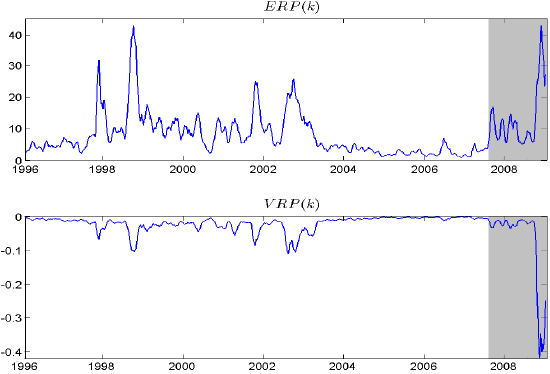Is fear of rare stock market plunges a major factor in the pricing of equities? In the March 2010 version of their paper entitled “Tails, Fears and Risk Premia”, Tim Bollerslev and Viktor Todorov apply highly empirical methods to examine the distribution of large rare events and the effects of these events on the equity risk premium and the volatility risk premium. Specifically, they define and measure an Investors Fears index driven by: (1) slow variation in investment opportunities (for example, due to economic and demographic influences); and, (2) large rare events (for example, due to economic and political crises). Using high-frequency (five-minute) prices for S&P 500 Index futures prices during 1990-2008 and prices for near-to-expiration out-of-the-money S&P 500 Index options during 1996-2008, they conclude that:
- On average, large rare events by themselves induce a nominal 5% equity risk premium as compensation for risk of disaster over the sample period.
- Traditional mean-variance frameworks, such as Modern Portfolio Theory (MPT), are poorly suited to manage this kind of risk.
- By comparison, compensation for slow variation in investment opportunities is modest.
- Large rare events account on average for over half of the variance risk premium observed over the sample period, with dramatic market declines dominating their contribution. In other words, “crash-o-phobia” plays a crucial role in the pricing of volatility.
The following graphs, taken from the paper, plot the contributions by month of large rare events to the equity risk premium [ERP(k)] and the volatility risk premium [VRP(k)] in percentages during 1996-2008. Monthly estimates are 22-day moving averages of the corresponding daily estimates. Dramatic fluctuations generally relate to economic/political crises. The negative volatility risk premium tends to mirror the positive equity risk premium, but imperfectly. Shaded areas are out-of-sample with respect to estimation of the average premium contributions described above

In summary, evidence suggests that fear of disasters accounts for large fractions, perhaps most on average, of both the equity risk premium and the volatility risk premium.
The paper is conceptually and mathematically abstract, but the conclusions may be important for understanding the MPT-resistant risks inherent in exploitation of the asset risk premiums.